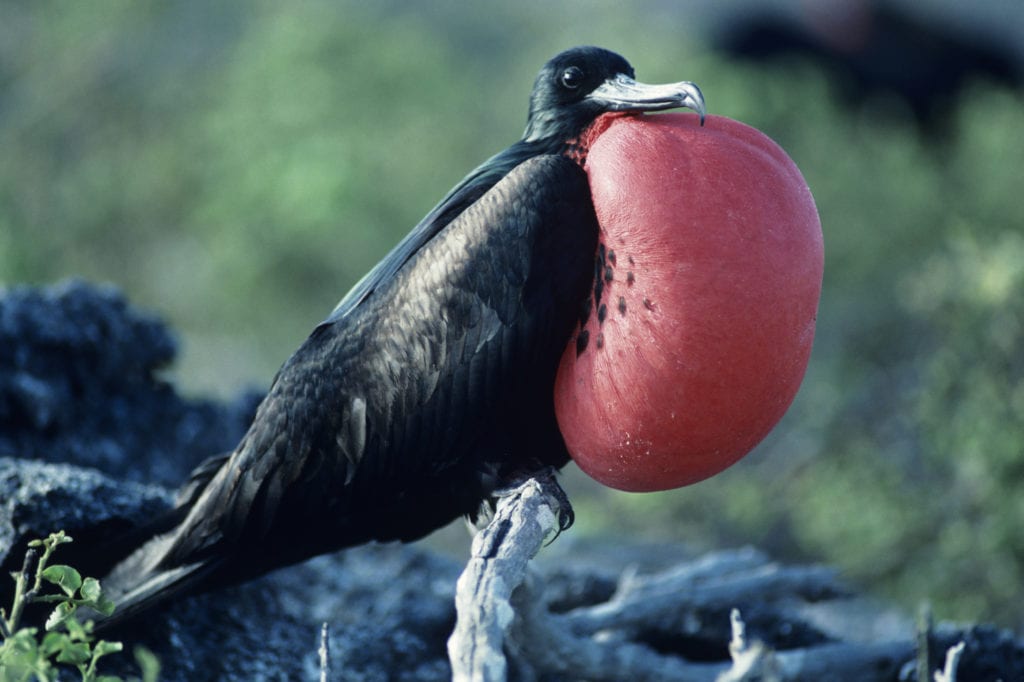Frigatebirds are unique and distinctive birds which are found in the regions surrounding earth’s tropical and subtropical oceans. Instantly recognizable for their bright red throat pouches, Frigatebirds inspire the imagination of human beings and have done so since ancient times. From the Nazca Lines, a set of ancient Peruvian geoglyphs, to modern dinosaur hoaxes, the Frigatebird’s striking appearance and fascinating features grip the human heart. (1)(2)
Known for their elaborate mating rituals and large breeding colonies, Frigatebirds are black seabirds with hooked bills, long wings that can span over seven feet, and male Frigatebirds have vibrant red pouches on their throats. Considered to be good fortune by many different cultural and maritime traditions, the Frigatebird is an animal that is rich with meaning and significance.
Frigatebird Symbolism and Meaning
Frigatebirds are quite often associated with good luck. Amongst the indigenous peoples of Oceania as well as the European cultures which would interact with these birds in the post-colonial world, the Frigatebird is thought to be a good omen for both sailors and fisherman. Because Frigatebirds eat the smaller fish and squid that are chased to the ocean’s surface by larger fish like tuna, as well as some smaller tuna too, the Frigatebird is often associated with the arrival of large fish. Obviously, schools of large meaty fish are excellent news for sailors. In some cultures, the Frigatebird is celebrated for ushering in plentiful fishing seasons. (3)
So, the Frigatebird may be seen as a symbol of good luck, times of plenty, and the beginning of a bountiful season.
Only male Frigatebirds possess that impressive sac, or gular pouch, for which these birds are best known. Unlike most seabirds, the Frigatebird is sexually dimorphic, which simply means that males and females of this species differ in appearance. For this reason, the Frigatebird may represent masculinity as well as various masculine traits. (4)
Frigatebirds engage in complex mating displays wherein sexually mature males inflate their gular pouches, spread their wings, make a variety of sounds, and swivel back and forth. Females flying overhead choose a mate based upon this display and fly down to greet him. After doing this, the pair will hold each others’ bills and shake their heads together before beginning the nesting process. The Frigatebird, then, can represent romance, courtship, and showiness. (5)
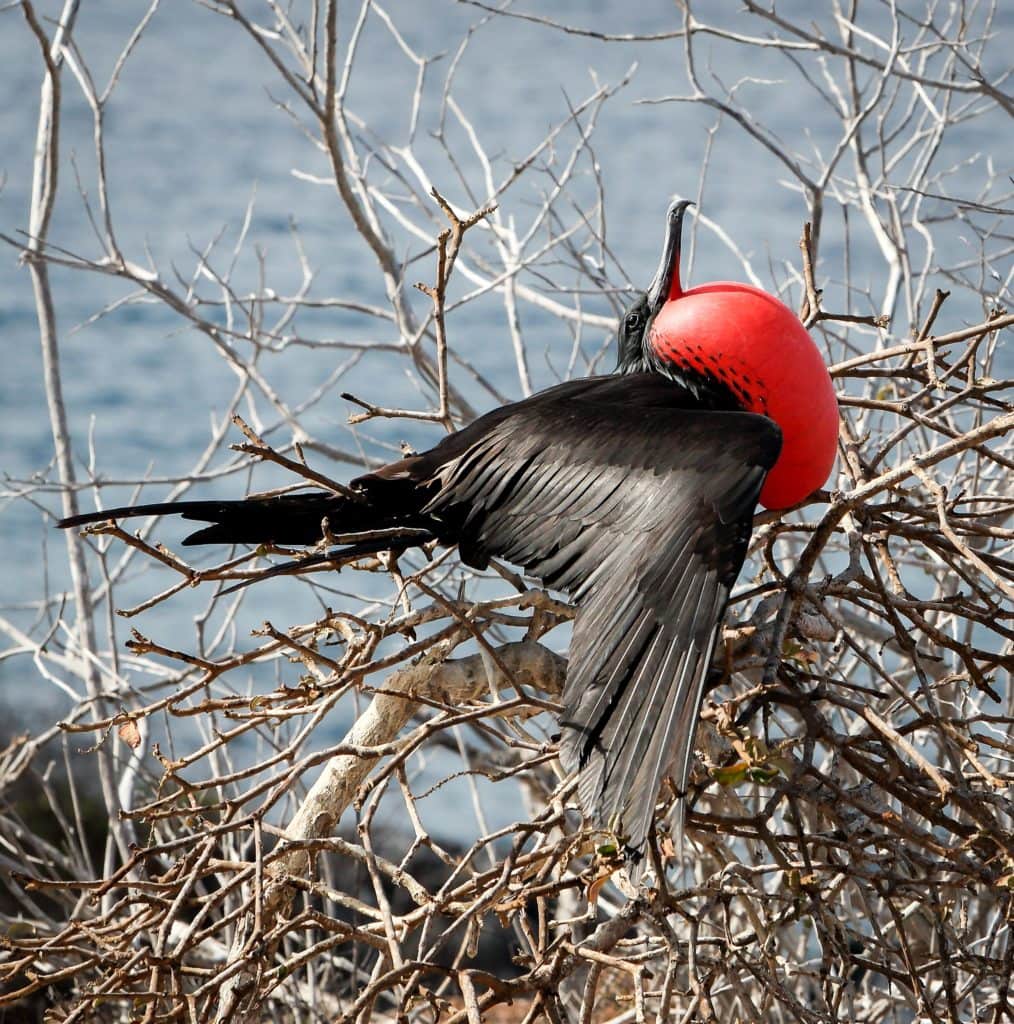
In their large colonies, Frigatebirds begin raising a single egg. This egg hatches into a weak altricial chick which will take up to an entire year to be independent and as many as eight more years to be mature enough to breed. So, the Frigatebird may represent childhood, immaturity, longevity, growth, and the attentive care that goes into rearing a child. (6)
Frigatebirds are also known to engage in “kleptoparasitic” behavior. This means that some portion of the Frigatebird’s diet is believed to be obtained through thievery. Frigatebirds will chase other birds in their colony, forcing them to drop their catch, and feast on the ill-gotten bounty. Frigatebirds may represent pirates, thieves, and lazy people. (7)
Finally, the Frigatebird is known to spend much of its life on the wing. The wandering flights of the Frigatebird can last for up to two months without ever landing. Because Frigatebirds cannot actually swim, a great deal of endurance is necessary to cross large stretches of ocean. So, the Frigatebird may represent a wandering spirit, travel, homesickness, or endurance. (8)
Frigatebird Native American and Indigenous Symbolism
Most indigenous cultures see the Frigatebird as a symbol of good luck which indicates that pleasant seas and bountiful fishing are on the horizon.
The people of Rapa Nui, or “Easter Island,” in the southeastern Pacific Ocean often depict the Frigatebird, alongside the Sooty Tern, as a sacred bird central to the ancient “Birdman cult” which venerated leaders based on their ability to collect bird’s eggs in a great competition. (9)
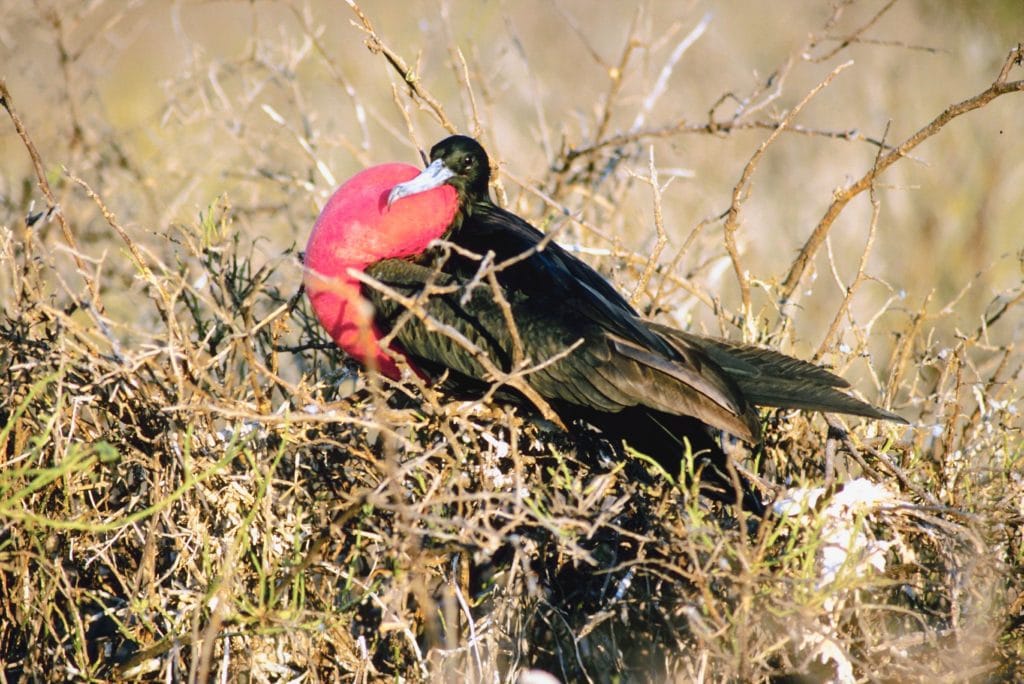
Amongst the adherents of the “Birdman cult,” the Frigatebird can be interpreted as symbolizing sanctity, leadership, and prowess.
Frigatebird Christianity Symbolism
The Frigatebird is neither present in the Bible nor commonly associated with Christian iconography. Nevertheless, this bird reminds me of the story of the great flood and of Noah’s Ark. After relentless flooding, Noah and the fauna of the earth were confined to the ark until a dove could signal to them that the floodwaters had receded and the earth was safe again. The Frigatebird cannot swim and yet must spend weeks and even months traversing the ocean without stopping too land. This long journey is reminiscent of the faith and tenacity that Noah had to exhibit in order to survive the flood and deliver all of the animals from destruction. (10)
Frigatebird Celtic Symbolism
Seabirds in Celtic stories are often connected with femininity, the brutal beauty of the sea, and the supernatural. Pair this with the fact that animals with red patches or markings often appear in myths as denizens of the Otherworld and you have a pretty good case for the fact that, though Frigatebirds are confined to the tropics and subtropics, the Celtic imagination would perceive them as otherworldly, mysterious, and magical animals. (111111)
Frigatebird in Dreams
Dreaming of a Frigatebird may signify a number of things depending upon the context. A dream which heavily emphasizes the male Frigatebird’s gular pouch may represent romantic competition or frustration. Dreaming of a young or immature Frigatebird may indicate that the dreamer feels underprepared for the demands of adulthood or nostalgic for the sheltered state of youth. After experiencing such a dream, one should consider whether their inner child requires some attention.
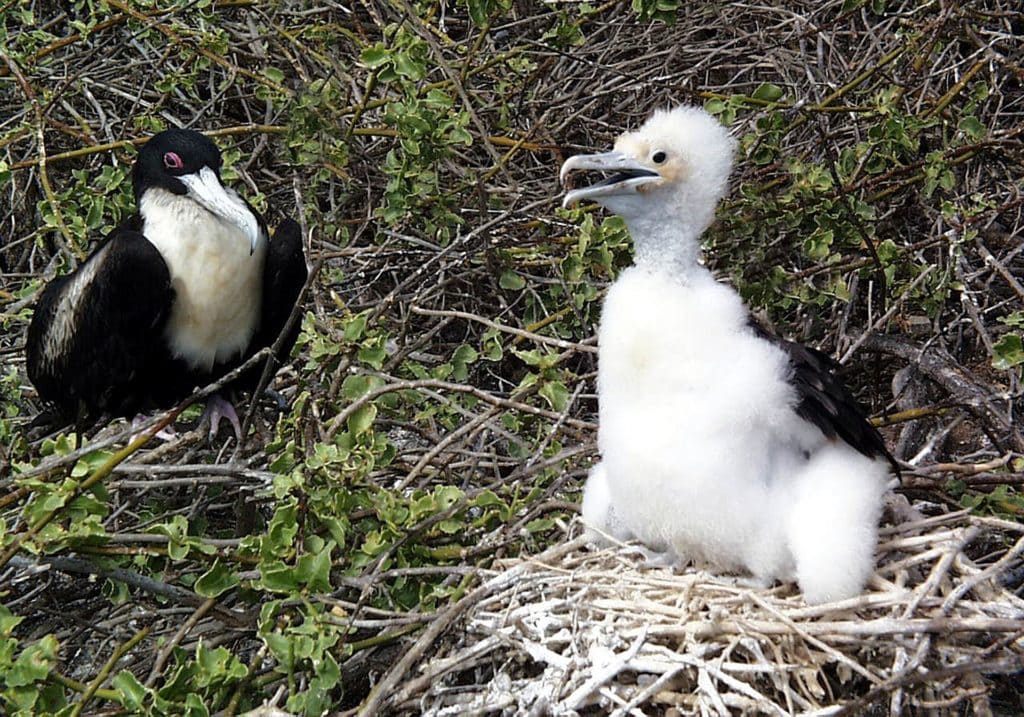
Dreaming of a Frigatebird in flight may indicate restlessness, wanderlust, or exhaustion. Dreaming of a Frigatebird that is fishing represents prosperity and good news on the horizon.
Frigatebird Encounters and Omens
Encountering a Frigatebird is generally thought to be good luck. These birds are a welcome sight for fishermen and sailors who believe that the Frigatebird brings schools of delicious fish with it when it appears. When you encounter the Frigatebird, remember to be grateful for all of the blessings that have come your way in the past. Appreciating what you have is sometimes the best way to welcome more blessings into your life.
Frigatebird in Mythology & Folklore
In 2010, a hoax video made the rounds on the internet claiming to depict a pterosaur alive and well. Several commentators, including some from the Smithsonian Magazine, pointed out that the “pterosaur” was quickly recognizable as a Frigatebird. (12)
This modern event demonstrates just how breathtaking and inspiring these birds are. To us now they provoke wonder, awe, and confusion. To ancient peoples these birds were reminiscent of the sacred.
Native American and Indigenous Mythology:
On the island of Rapa Nui, known by most Westerners as “Easter Island,” birds have long been held to be sacred creatures. According to legend, the island of Rapa Nui had no birds at all in ancient times. Then, a young witch named Hitu found a skull which she took back to her cave and kept as her treasure. One day the sea swelled and took her skull. Hitu dived after it, but before she could retrieve her treasure, the skull became the creator god Make Make. Make Make and Hitu came to an island inhabited by a spirit who guarded a large population of seabirds. Make Make was impressed with the birds and placed some pairs on Rapa Nui as a gift to the people. To his surprise, though, the people devoured the eggs of the birds and they were unable to reproduce.
Angry, Make Make declared the eggs taboo to collect or eat outside of special periods during the year. This secured the seabirds’ existence and the first “manutara,” or “luck bird” was born. The manutara is known to be the Sooty Tern. In the ensuing years, a competition would develop over who could collect the manutara’s eggs during the special open season where collecting them was allowed. Participants in this competition must climb down the cliff face of a volcano and swim through shark-inhabited waters to collect the first egg of the season. He who succeeds in this race is dubbed “Tangata Manu” or “birdman” and is venerated as the island’s ceremonial king for the year. While much of the “Birdman cult” practices surround the Sooty Tern, depictions of the Tangata Manu usually involve features that more closely resemble the Frigatebird. Manutara itself, which is understood to be the Sooty Tern, looks more like the Frigatebird in many artistic depictions. (13)
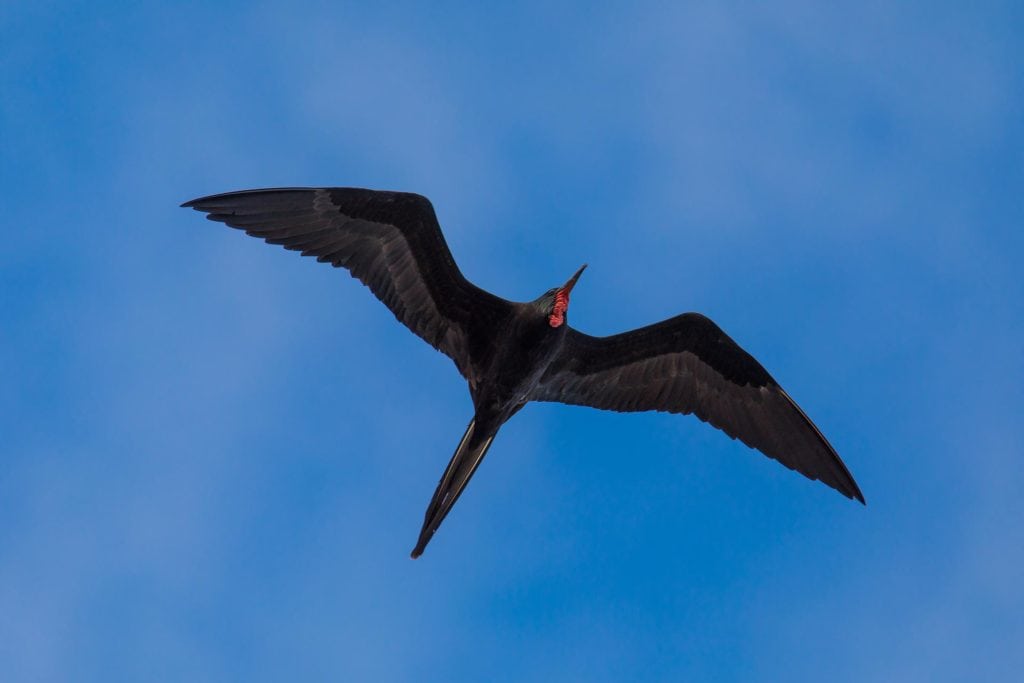
The Frigatebird is considered sacred in a number of cultures which overlap with its habitats. The most famous cultural depiction of this bird is, perhaps, the Nazca Lines. The Nazca Lines are a number of monumentally large etchings in the earth known as “geoglyphs.” Difficult to make out without an aerial view, much about the construction of these lines remains a mystery to this day. In any case, the presence of a Frigatebird geoglyph proves the sacred significance that the Frigatebird must have held for the architects of this monument. (14)
Frigatebird Spirit Animal
If the Frigatebird is your spirit animal then you are extroverted, confident, and highly expressive. People with the Frigatebird spirit animal live their lives with their hearts on their sleeves. Drawn to many forms of self-expression, somebody with this spirit animal is likely to find their passion in artistic pursuits such as fashion, music, visual arts.
The Frigatebird is highly social and lives in large colonies. Despite this, these birds can be extremely antagonistic towards one another, often stealing food from their peers. If your spirit animal is the Frigatebird then you may find that socializing comes easily to you, but deeper bonds are more challenging. Letting people in is tough, but the Frigatebird knows that to find “the one” you must continue to put your authentic self on display.
Frigatebird Totem Animal
The Frigatebird totem animal is associated with endurance and courage. Though unable to swim, the Frigatebird spends its life hovering over the roiling waters of the ocean blue. For days, weeks, and even months the Frigatebird will subsist on meals that it catches while on the wing and will sleep in the air with no solid ground on which to land. While such situations may sound terrifying, the Frigatebird braves this scenario throughout its life. People with the Frigatebird totem animal are gifted when it comes to managing fear and enduring difficult and exhausting situations.
If the Frigatebird is your totem animal then you are excellent at adapting, improvising, and relying on the faith that you have in yourself in order to persevere.
Frigatebird Power Animal
The power of the Frigatebird lies in competition. Like the people of Rapa Nui who chose their leader based on his ability to impress in a grueling physical contest, the Frigatebird too must compete for a mate, a safe spot to raise its young, and food. The magnificent red gular pouch of the Frigatebird represents the fiery spirit of competition which flows in you. If the Frigatebird is your power animal than competitiveness flows through your veins and manifests in an intense drive to succeeed, to surpass your limits, to be the best, and to fulfill your potential.
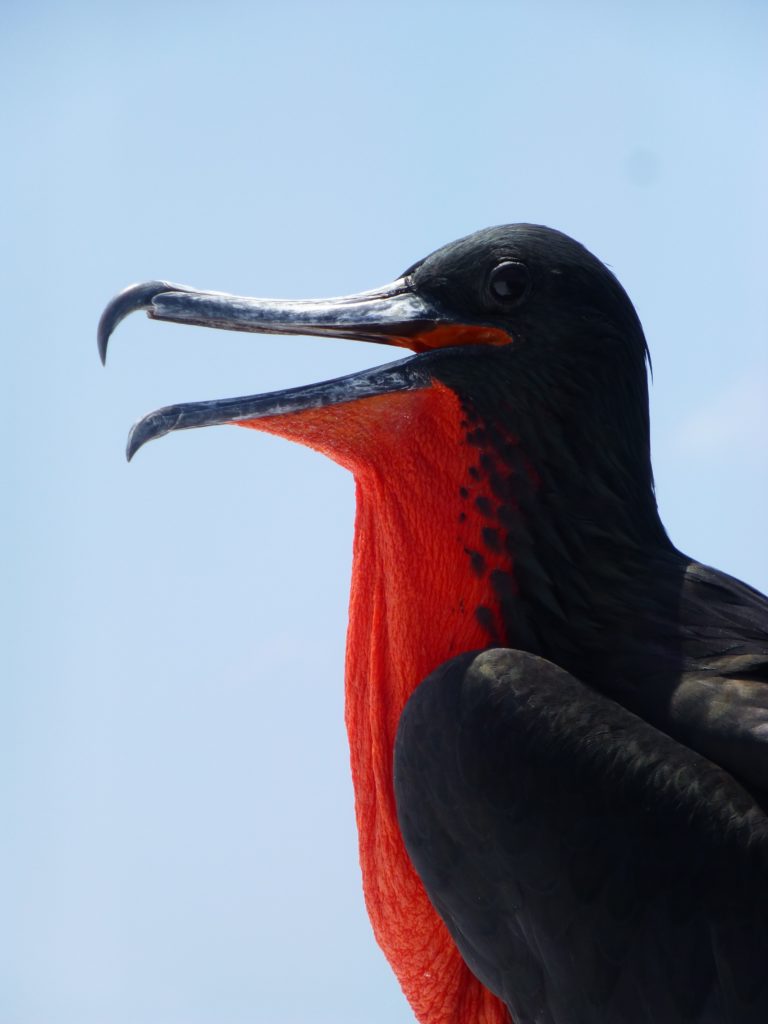
Frigatebird Tattoo Meaning
A Frigatebird tattoo may represent indigenous pride, especially for people who originate from the islands of Oceania which hold the Frigatebird dear. People from Rapa Nui may want to represent the ancient “Birdman” cultural practice with a Frigatebird tattoo.
Additionally, people who feel drawn to wandering or traveling may desire a Frigatebird tattoo out of solidarity for the Frigatebird’s long journeys or out of superstition, since this bird is thought of as a good luck charm.
Further meanings for a Frigatebird tattoo include: competition, masculinity, romance, courtship, immaturity or childhood, piracy or thievery, and optimism.
Conclusion
The Frigatebird is a truly striking animal to behold. Even females, which lack the gular pouch, have wingspans which rival some of the largest birds on this earth. When viewing such an amazing animal, its easy to place oneself in the shoes of an ancient individual who, upon viewing this bird, considered it to have the qualities of the heavens themselves. The Frigatebird is a stunning reminder of the incredible biodiversity of this planet and the wondrous treasures which the earth has given us in the form of its many amazing animals.

